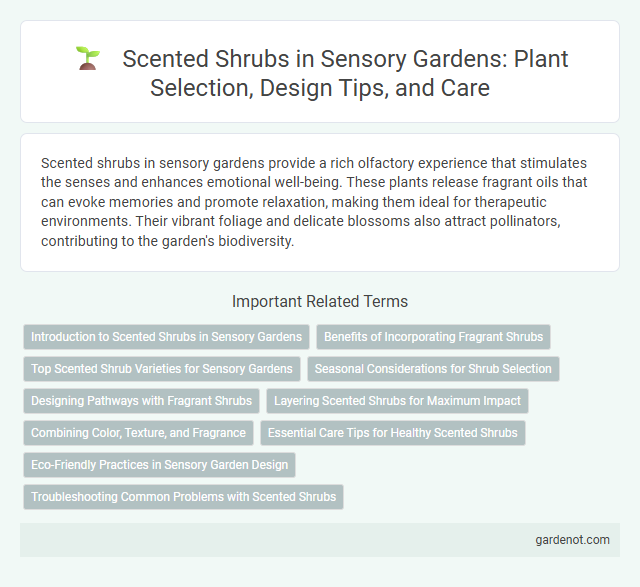Scented shrubs in sensory gardens provide a rich olfactory experience that stimulates the senses and enhances emotional well-being. These plants release fragrant oils that can evoke memories and promote relaxation, making them ideal for therapeutic environments. Their vibrant foliage and delicate blossoms also attract pollinators, contributing to the garden's biodiversity.
Introduction to Scented Shrubs in Sensory Gardens
Scented shrubs in sensory gardens provide aromatic stimulation that enhances sensory experiences through natural fragrances such as lavender, rosemary, and lilac. These plants contribute to therapeutic benefits, including stress reduction and mood improvement, making them essential components in accessible garden design. Their diverse scents attract pollinators, supporting biodiversity while engaging visitors' olfactory senses.
Benefits of Incorporating Fragrant Shrubs
Incorporating fragrant shrubs such as lavender, lilac, and rosemary enhances sensory gardens by stimulating the olfactory senses and promoting relaxation and stress relief. These scented shrubs attract pollinators like bees and butterflies, contributing to biodiversity and supporting local ecosystems. Their seasonal blooms provide visual appeal alongside their aromatic benefits, making them versatile and functional additions to any sensory garden design.
Top Scented Shrub Varieties for Sensory Gardens
Top scented shrub varieties for sensory gardens include lavender, rosemary, and jasmine, known for their fragrant blooms and leaves. These shrubs not only provide aromatic experiences but also attract pollinators like bees and butterflies, enhancing garden biodiversity. Selecting drought-tolerant and low-maintenance scented shrubs ensures long-lasting sensory appeal in various climates.
Seasonal Considerations for Shrub Selection
Choose scented shrubs that bloom in different seasons to ensure year-round fragrance and sensory stimulation in the garden. Consider deciduous varieties like Lilac (Syringa vulgaris) for spring blooms and evergreen options such as Sweet Box (Sarcococca) for winter scent. Assess local climate and soil conditions to match shrub species that thrive and maintain consistent aromatic presence throughout the year.
Designing Pathways with Fragrant Shrubs
Designing pathways with fragrant shrubs enhances sensory gardens by engaging visitors' sense of smell and guiding their journey through the space. Shrubs such as lavender, rosemary, and lilac offer distinct scents that vary with the seasons, creating dynamic olfactory experiences. Strategic placement along winding paths ensures that the fragrance is experienced at different intensities, optimizing both aesthetic appeal and sensory stimulation.
Layering Scented Shrubs for Maximum Impact
Layering scented shrubs like lavender, rosemary, and mock orange creates a dynamic sensory experience by combining diverse fragrances that bloom at varying times. Strategic placement enhances olfactory depth, with taller shrubs providing a fragrant backdrop while lower-growing varieties add intensity at eye level. This multi-layered approach maximizes scent diffusion throughout the garden, attracting pollinators and enriching visitor engagement.
Combining Color, Texture, and Fragrance
Scented shrubs in sensory gardens blend vibrant colors, varied textures, and pleasing fragrances to create a multi-sensory experience. Varieties like lavender, lilac, and rosemary offer visually striking foliage alongside aromatic blooms, enhancing both aesthetic appeal and sensory stimulation. This combination encourages engagement by appealing simultaneously to sight, touch, and smell, making it ideal for therapeutic and educational garden designs.
Essential Care Tips for Healthy Scented Shrubs
Scented shrubs thrive in well-drained soil with consistent moisture and partial to full sunlight exposure, promoting robust growth and fragrant blooms. Regular pruning after flowering encourages new growth and maintains shape, while applying balanced fertilizer in early spring supports nutrient uptake and flower production. Monitoring for pests like aphids and treating promptly with natural insecticides helps prevent damage, ensuring healthy, aromatic shrubs year-round.
Eco-Friendly Practices in Sensory Garden Design
Incorporating scented shrubs such as lavender, rosemary, and lilac into sensory garden design enhances aromatic experiences while supporting eco-friendly practices by attracting pollinators and reducing the need for chemical fertilizers. These shrubs thrive with organic mulching and drip irrigation systems that conserve water and maintain soil health. Selecting native scented plants further promotes biodiversity and minimizes environmental impact in sustainable sensory gardens.
Troubleshooting Common Problems with Scented Shrubs
Scented shrubs often face issues such as fungal infections, pest infestations, and nutrient deficiencies that can diminish their fragrance and overall health. Effective troubleshooting includes regular inspection for signs of powdery mildew or aphids, ensuring well-drained soil, and applying appropriate fungicides or insecticides tailored to the specific shrub species. Maintaining optimal growing conditions with balanced fertilization and adequate sunlight helps prevent common problems and promotes robust, aromatic blooms.
Scented shrub Infographic

 gardenot.com
gardenot.com